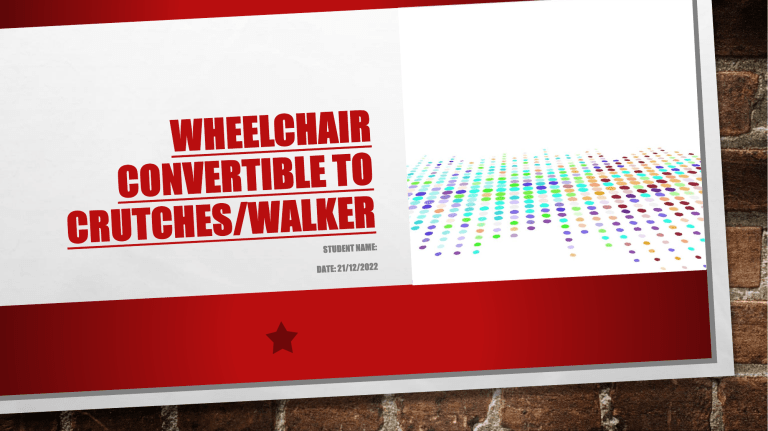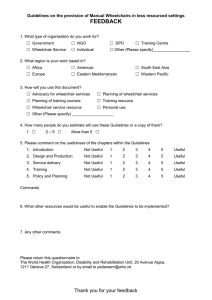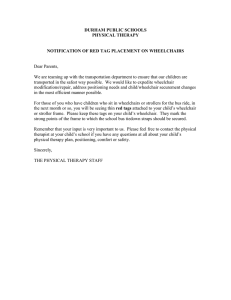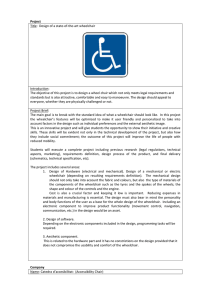
TABLE OF CONTENT Problem Definition Problem solution Convertible Wheelchair Objectives Introduction Business Model Conclusion References PROBLEM DEFINITION Transferring disabled person from wheelchairs to stretchers or while they are wanting to walk with the help of a walker or on a medical bed or stretcher is always a problem for the operator or nurse. A wide variety of wheelchairs are available today, driven by a person's needs and desires but can not be convertible from one form to another.. CONVERTIBLE WHEELCHAIR WE propose the design of a convertible stretcher for wheelchairs and then walkers, which is beneficial for medical field. It would be easily maintained and operated either by the patient according to his wish to walk with a walker or by sitting in a wheelchair or sleeping on a stretcher by staff according to the patient's / disabled person comfort. FOLLOWING ARE THE MAIN OBJECTIVES OF WORK. OBJECTIVES Satisfying the needs of the disabled people. Make it cheaper by using new mechanism. Works reliably under different operating conditions. To save space. INTRODUCTION • • • With passing of time technology influences these inventions. Technology is knowledge of making things easier and s problems solver. So as technology emerges, many people to demand more to make their lives much easier and more comfortable, especially for our PWD (person with disability). Some used a light material, or it can be ecofriendly material, also comes with different designs to get it to the people. Devices used by the patient to stand and provide support to the patient while walking and stretchers mobile devices used to transport patients from one place to another. These medical mobility aids are used in hospitals and clinics to help patients. The stretcher has a simple design, and the patient needs it assistant support during transport from one place to another. While the walker is used by the patient to walk without any aid of any aid and wheelchair is designed so that the device can be operated by any patient by hand or with someone's help. WORKING OF WHEELCHAIR The uniqueness of this design is that when the product is in stretcher or bed mode, the height will match the conventional bed. The height is adjustable for a bed, stretcher or wheelchair or any desired height. Conversion from wheelchair to bed or stretcher or vice versa can be done by both the patient and the handler. Below are different elements platforms. RATCHET MECHANISM ARMREST BACKREST LEG SUPPORT SEAT CUSHIONS TIRES ADVANTAGES • • • • • • • This project would help people with disabilities to manage themselves easily. Loss of transportation time and would be able to take the convertible wheelchair anywhere want. It is quite affordable so anyone can easily get and use it. A wheelchair can be used in a hospital for temporary use for some patients. Also, because crutches are easy to use. Our study shows that 80% of space can be saved when using a wheelchair. A convertible stretcher instead of using a walker and wheelchair stretcher separately. This design eliminates steps transferring patients from a wheelchair to a stretcher and vice versa, as caring for disabled people becomes difficult. Our design will thus be an effective mobility aid for the medical field adding walker features would make the product more reliable, more innovative and could satisfy patient needs to a much higher degree. COST OF PRODUCT NO. NAME • 1. NUT & BOLT QUANTITY COST (USD) 30$ • 2. SPRING & WHITE CLAMP POWER 35$ • 3. SCREW AND NUT 20$ • 4. STOPPER & DOOR HINGES 4 15$ • 5. ALUMINUM PIPE 1 15$ COST OF PRODUCT CONTINUE • 5. ALUMINUM PIPE 1 15$ • 6. PLYWOOD 2 50$ • 7. RUBBER SHOE 4 30$ • 8. GLASS FIBER 27$ • 9. DELIVERY CHARGES 50$ • 10. MISCELLANEOUS 50$ GRAND TOTAL = 322$ CONCLUSION “to make our society more independent and able to fulfill its own needs through the field of mechanics. " The main goal of this product is to make the assistant's life easier and ensure that the patient is not injured during treatment process. This product eliminates the step of moving the patient from the bed or gurney to the wheelchair and vice versa. On the contrary, we could make the disabled person's life more fulfilling and independent. REFERENCES • 1. James kauzlarich, wheelchair caster shimmy II: damping, journal of rehabilitation research and development, 37(3), 2000,305-315. • 2. Cooper, corfman, fitzgerald, boninger, performance assessment of a pushrim activated power assisted wheelchair, IEEE trans control sys tech, 10(2), 2002, 1063-1072. • 3. Rory, cooper, wheelchair selection and configuration, (new york, springer publishing company, 1st edition, 1998). • 4 Daniel jolly, wheelchair transfer, proc, 15th IEEE mediteranian electrochemical PES winter meeting, columbus, 2010, 170-178. • 5. Amos winter, mechanical principle of wheelchair design, international journal of mechanical engineering and technology,7(2), 2010, 261-265.




